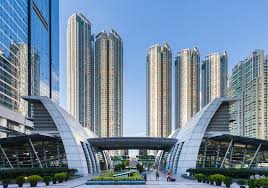Physical Address
304 North Cardinal St.
Dorchester Center, MA 02124
Physical Address
304 North Cardinal St.
Dorchester Center, MA 02124

Integrating rail and property development is the cornerstone of the MTR’s success. In the U.S., coordination between transit authorities and developers tends to be mediocre at best. In Hong Kong, however, the MTR is both the transit authority as well as the property owner, and this makes all the difference.
Most attempts at transit-oriented development in the U.S. involve multi-party negotiations. The agency responsible for the transportation system haggles with different developers interested in undertaking projects along the line. Instead of implementing a unified plan, the transit agency has to negotiate specific agreements with each developer. And, because the priorities of the transit agency and the developers are never perfectly aligned, development agreements become subject to second-best compromises. Further, any disputes that arise once significant capital has been committed are costly to resolve.
This arrangement makes leveraging land values difficult as well. Developers frequently get tax breaks as an incentive to undertake projects. Whether abatements on property tax or straight-forward rate reductions, tax incentives typically preclude the use of land values to help fund transit. And, even without special incentives, major property owners who stand to benefit from proximity to a transit system have every reason to resist tax increases of any kind if there’s a chance of free-riding.

The MTR, on the other hand, uses the integrated rail-property development approach which combines the two roles of landlord and transit developer. The MTR owns the right-of-way as well as the surrounding properties. This removes the necessity of extended negotiations, having to settle for second best solutions, and the potential downside of disagreements partway through a project.
By combining the functions of landlord and transit developer, the MTR is also able to internalize land values. The rail line drives up the value of the MTR’s properties and that value covers the capital costs of the MTR’s rail lines.
In 1937, the economist Ronald Coase asked why, if market exchange is such a good way to allocate resources, do firms even exist?
The short answer? Transaction costs.
Participating in a market comes with a price, and in some instances, the cost of participation is more than it’s worth. When transaction costs are too high, firms avoid them by internalizing specific functions and allocating resources at the discretion of management. This is not unlike the way in which socialist command economies deployed resources, albeit on a much smaller scale, and within an organization that’s actually responsive to external price information.
In many industries, falling transaction costs have brought about a wave of decentralization, supplanting the old paradigm of Fordist vertical integration. Younger companies now specialize in a narrower range of core competencies and outsource the rest. Apple, for example, is really a design firm that uses a global network of manufacturing and logistics partners to get its products into consumer hands.
In the case of transit development, however, transaction costs remain high. Technological innovation hasn’t made construction much less capital intensive or shortened time horizons for investment. This means that the costs of coordinating transit and property development mentioned above have remained persistent. What the integrated rail-property development model suggests in theory, and the MTR demonstrates in practice, is that a little centralization could bypass these costs entirely. To paraphrase Coase, there’s a price to pay for using prices; and in the case of transit development, that price may still be far too high.
Part 2 of 2 covering the policies and institutions behind mass transit in Hong Kong
Above ground space is spoken for. How about subterranean space?
i love this city , HONGKONG . building everywhere.. LOL
celana jeans pria
[…] Require Sound Transit to use public capital for profit, becoming a master developer and creating massive TOD on all of its projects as part of its financial plan (see: Hong Kong). […]